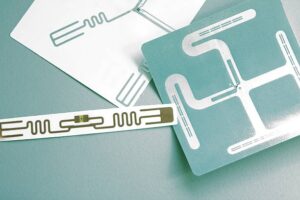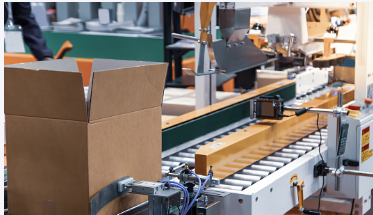With RFID retail, retailers can manage inventory control more efficiently and accurately. It improves productivity and enables a better customer experience.
It also reduces cycle count time and automatically triggers reorders at safety stock levels. It eliminates manual processes susceptible to error and makes for a more reliable supply chain.
Inventory Management
 Retailers with expensive merchandise and high omnichannel sales need ultra-high inventory visibility across stores and warehouses. RFID provides this with fast, automatic inventory counting and inbound/outbound shipping and receiving.
Retailers with expensive merchandise and high omnichannel sales need ultra-high inventory visibility across stores and warehouses. RFID provides this with fast, automatic inventory counting and inbound/outbound shipping and receiving.
Compared to barcode scanning, RFID tags provide much more data for tracking items. They also have a much wider range of applications, from tracking assets like equipment and tools in a warehouse to improving the retail shopping experience.
For example, high-end apparel and fashion retailers often apply RFID to merchandise at the item level. It allows them to proactively order an item’s specific size, colour or design before it runs out in stores. Then, when customers purchase online for in-store pickup, the store can have a highly accurate and up-to-the-minute inventory count to confirm that they have the item in stock.
In addition, RFID allows for automated returns. It saves a tremendous amount of labour costs in distribution centres and ensures that returned merchandise gets back into the salable inventory pool quickly and efficiently.
RFID can be used to detect theft and other operational issues. Retailers can set up stationary readers at checkouts and other store areas to capture real-time data that alerts them when a product is moved from its location. It can include perishables from refrigerated cases or small items like nuts and bolts dropped in the wrong bin at a hardware store.
Asset Management
The cost of RFID retail tag systems has fallen dramatically over recent years, making them affordable for even the smallest retail operations. Combined with sophisticated inventory tracking software, the benefits for small and medium businesses have never been greater.
Whether you need to track stock, tools, IT devices, vehicles or other high-value items, RFID can save time and money while improving accuracy and security. Place a reader near an item to read the data it emits through its repetitively pulsating radio waves. This information can then be collated and used to make informed decisions.
A basic use case for RFID is accurately measuring and monitoring warehouse stock levels, eliminating some of the most labour-intensive aspects of traditional inventory processes. It allows retailers to react quickly to changes in demand and to minimize losses from inventory shrinkage or theft.
On the shop floor, RFID can help identify products that are selling out quickly and enable staff to order replenishment stock proactively. It can also highlight when the estimated date to zero (ETZ) for a particular SKU has been reached in-store, allowing retailers to take action before the situation worsens.
Security
The basic use case for RFID is a highly accurate inventory system, particularly in a warehouse context. It helps to eliminate human error and makes doing stock tasks faster and more efficient. It also allows retailers to react quickly to shopper demand and ensures they can meet or exceed sales targets.
Many high-end brands and retailers with expensive merchandise and strong omnichannel sales use RFID for loss prevention and to optimize their inventory management processes. The technology can act like an electronic article surveillance (EAS) system at the store door, alerting associates to merchandise that’s trying to leave without being sold or that has been removed from its original packaging or altered in some other way.
Customer Experience
With accurate inventory visibility in real-time, retailers can offer a top-tier customer experience. It can range from providing convenient omnichannel services, such as allowing customers to reserve an item in an online store and pick it up in a physical store within an hour, to helping customers find specific items on the shop floor.
The granularity of RFID retail data also helps to improve the customer experience. Insights can be gained on individual product performance, including how well or poorly particular sizes are selling and what’s driving this demand. These insights are naturally actionable and allow retail teams to take proactive steps to move, replenish or discount stock accordingly.

 One of the most popular
One of the most popular  When looking for a website design Adelaide company, look for one that is experienced and professional. It will help ensure that your website is designed in a way that will attract traffic and increase your business. Moreover, it will allow you to focus on other aspects of your business while leaving the technical work to professionals. Nicholls Web Consulting Adelaide SEO has a proven track record of increasing website traffic and customer relationships for various companies. These include a 100-year-old family-owned business that pioneered interior services and a furniture retail chain.
When looking for a website design Adelaide company, look for one that is experienced and professional. It will help ensure that your website is designed in a way that will attract traffic and increase your business. Moreover, it will allow you to focus on other aspects of your business while leaving the technical work to professionals. Nicholls Web Consulting Adelaide SEO has a proven track record of increasing website traffic and customer relationships for various companies. These include a 100-year-old family-owned business that pioneered interior services and a furniture retail chain. Whether for beverages, food items, nutraceuticals, or cleaning products, the correct colourful label can make a difference in your product’s sales. It can show the world what you stand for, make people remember your brand, and help potential customers decide if your product is right for them. Colours also have a psychological effect on consumers. Learn how to use this knowledge to your advantage in your label design.
Whether for beverages, food items, nutraceuticals, or cleaning products, the correct colourful label can make a difference in your product’s sales. It can show the world what you stand for, make people remember your brand, and help potential customers decide if your product is right for them. Colours also have a psychological effect on consumers. Learn how to use this knowledge to your advantage in your label design. If you have
If you have  RFID tags, readers, and the software that runs them aren’t cheap. Cost can depend on many factors, including the type of tag you need and the range it operates at. For example, passive tags operate over a smaller range than active and semi-active tags, so you may need a larger reader to cover your entire operation.
RFID tags, readers, and the software that runs them aren’t cheap. Cost can depend on many factors, including the type of tag you need and the range it operates at. For example, passive tags operate over a smaller range than active and semi-active tags, so you may need a larger reader to cover your entire operation.